If you’re heading out for a hike in the winter, you are probably going to encounter ice and snow. But how will you stop yourself from slipping? Should you bring microspikes? Or crampons? Or snowshoes? And what’s the difference? In this post, I’ll break down microspikes vs. crampons vs. snowshoes.
I’ve been winter hiking and snowshoeing for over 20 years. I also used to work at the head office of a large outdoor retailer where I wrote about hiking gear, including writing staff training materials. So I’ve got a fair amount of winter knowledge to share.
This guide to winter traction devices includes:
- A comparison chart for microspikes, crampons and snowshoes showing their strengths and weaknesses
- Microspikes: What are they? When to use them? And my picks for the best microspikes.
- Crampons: What are they? When to use them? And my picks for the best crampons.
- Snowshoes: What are they? When to use them? And my picks for the best snowshoes.
- Other winter traction devices: A quick overview of other traction devices including Yaktrax, STABILicers and more and how they stack up against microspikes.
Hey there: Some of the links in this post are affiliate links, which means I earn a small commission at no cost to you. Thanks for your support. -Taryn
Microspikes vs. Crampons vs. Snowshoes Comparison Chart
| Microspikes | Crampons | Snowshoes | |
|---|---|---|---|
| Flotation in deep snow | None | None | Excellent |
| Grip on packed snow and ice | Good | Excellent | Fair |
| Safety on steep slopes | Good | Excellent | Poor |
| Ease of on/off | Good | Poor | Fair |
| Footwear compatibility | Excellent | Poor | Excellent |
| Ease of use | Excellent | Fair | Good |
| Packability and bulk | Excellent | Good | Poor |
| Lightweight | Good | Fair | Poor |
| Durability | Fair | Excellent | Excellent |
| Affordability | Good | Fair | Fair |
Microspikes
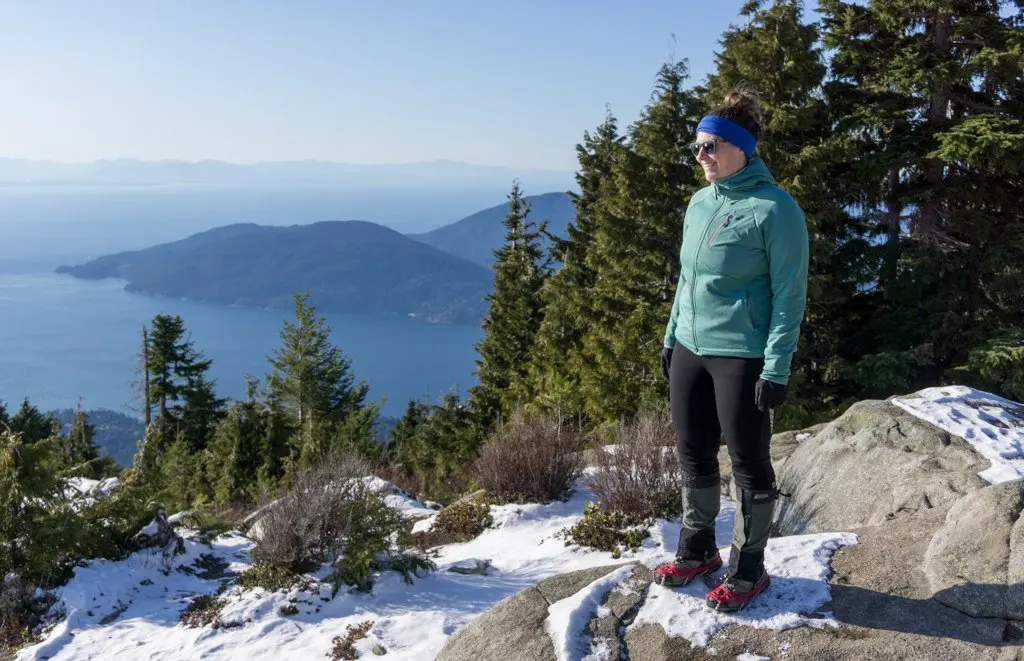
Best for: Hiking or trail running on packed snow or icy trails
Pros: Inexpensive, lightweight, can be worn with any footwear, good traction, easy to take on and off
Cons: Not safe for steep slopes, don’t provide flotation in deep snow, not as durable
What are microspikes?
The term “microspikes” can mean a lot of things. It gets even more confusing because even though “microspikes” is actually a trademarked name from Kahtoola, people tend to refer to all similar products as microspikes. (It’s kind of like how everyone calls adhesive bandages band-aids, even if they aren’t made by Band-Aid brand.)
In general, microspikes have a flexible rubber-like plastic harness that stretches to fit around all kinds of boots and shoes. Some also have a velcro toe strap.
On the bottom, they have metal teeth connected by stainless steel chains. The teeth are usually fairly short (less than 1/2″/1.25 cm). You can wear microspikes with flexible footwear like trail runners since the metal chains aren’t rigid.
Heads up: You might see products with a stretchy harness and then studs or just chains on the bottom. These are NOT microspikes. While these go by a lot of other names, they provide less traction. More on these in the Other Traction Devices section below.
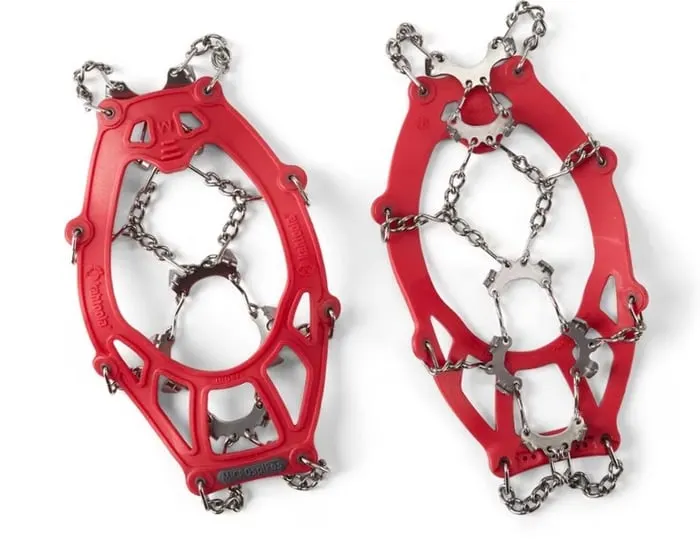
When to use microspikes?
Microspikes are best suited to hard-packed snow or icy trails. They excel on flat and low-angle terrain – they don’t provide enough secure grip for steep slopes, especially where a fall could be dangerous. The spikes on microspikes also aren’t very long. That means that if there is a thin layer of snow over ice, the spikes might not be long enough to bite into the ice.
I think microspikes are great for winter trail running and hiking. The spikes are fairly durable, which means you can wear them for short periods on bare dirt.
I keep my microspikes in my backpack for winter trips when I expect freezing temperatures. They are good to have when conditions are too slippery for hiking boots.
I also bring them snowshoeing as they are much more secure in steep terrain than snowshoes. (More on that in the snowshoes section below.) In hard-packed snow, they are also much more comfortable to wear than snowshoes since you have a more natural stance.
Check trail conditions before you go to figure out if microspikes are the right choice. My guide to how to find trail conditions has lots of resources.
My picks for the best microspikes
I have both the original Kahtoola Microspikes and Hillsound Trail Crampon Ultra (which despite the name are NOT crampons). They are both great, but I have a slight preference for the Hillsounds since they have a velcro toe strap, which improves the fit.
Other good microspike options include Black Diamond Access Spikes and Black Diamond Distance Spikes.
There are lots of cheap knock-off microspikes on Amazon. The reviews on them aren’t great – lots of people say that the spikes bend and the plastic harnesses rip. But if you want budget microspikes, the best ones on Amazon are the Cimkiz microspikes.
Crampons
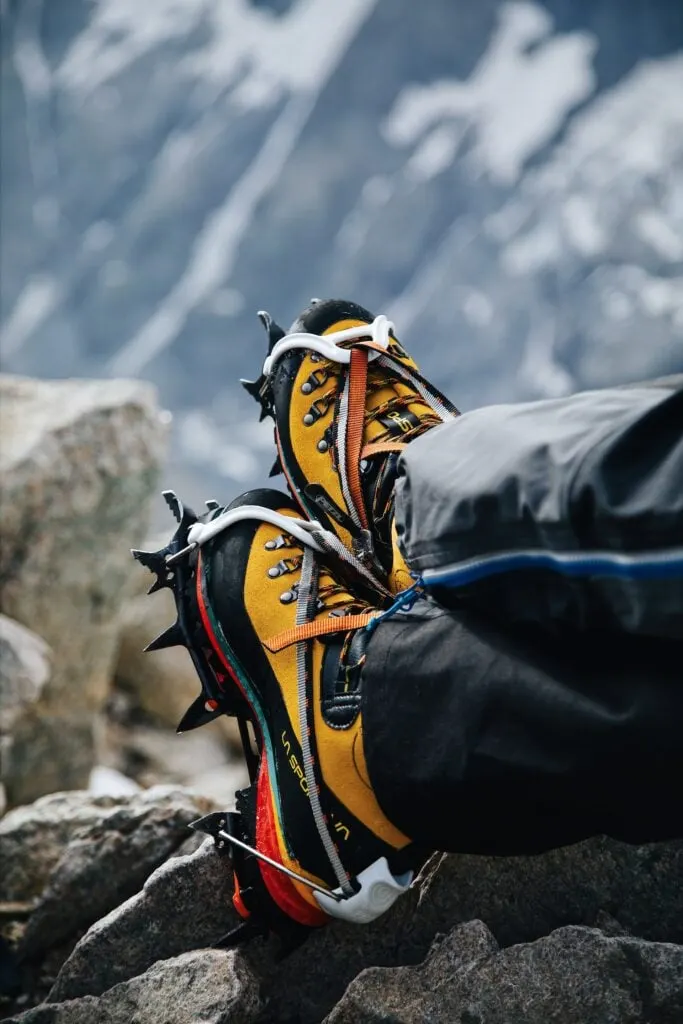
Best for: Mountaineering, ice climbing, or hiking on steep ice or snow slopes
Pros: Very secure attachment to boots, tons of grip, durable
Cons: Bulky, heavy, expensive, requires training to use, may require specialized footwear, doesn’t provide flotation in snow, time-consuming to take on and off
What are crampons?
Mountaineers developed crampons to help them traverse steep and precipitous slopes on glaciers, ice, and frozen waterfalls. They consist of a two-piece metal frame that fits under the sole of your boot. The frame is linked by a center bar that is sometimes a bit flexible for easier walking. The frame usually has plastic plates under the ball and heel of the foot to prevent snow build-up
Spikes stick out of the bottom of the frame. There are usually four spikes under the heel and six or eight under the forefoot. Some crampons have two front points as well, which can be used to kick your toe into vertical slopes. One of the main differences of microspikes vs. crampons is that on crampons, the spikes are sharper and longer.
Crampons attach to your boots very securely with a system of straps and wire bails that only work with specialized mountaineering boots – these boots have special welts or grooves on the heels and toes for the crampons to attach to. These are called step-in crampons.
It is also possible to get crampons that only attach with straps and be used with any boot. These are called strap-on crampons. However, since they don’t attach as securely as step-in crampons, they are best for less technical terrain.
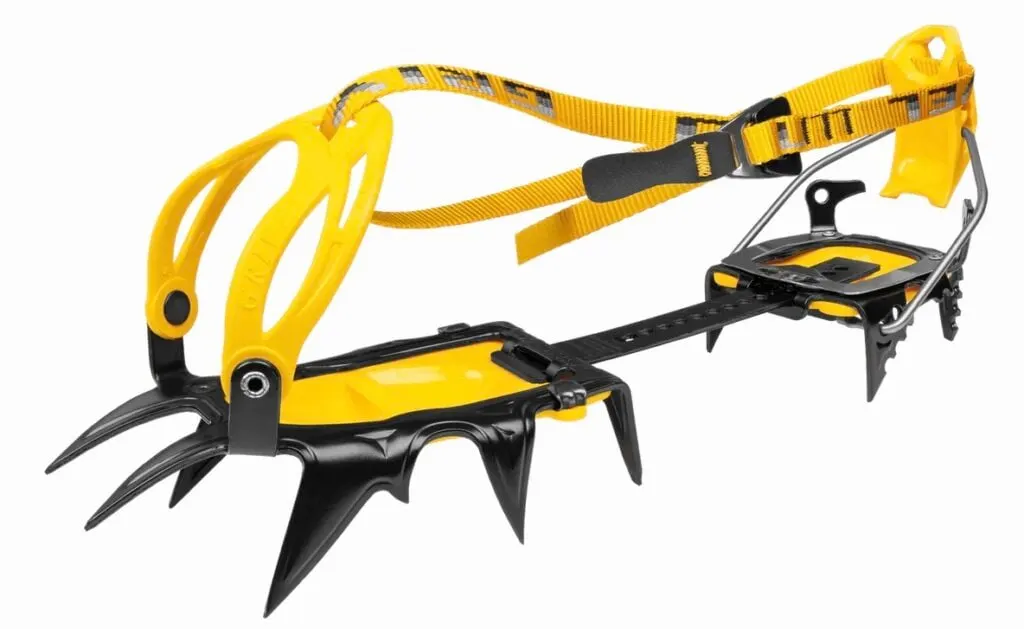
When to use crampons?
Crampons are the most helpful on steep slopes with firm snow or ice. They bite much deeper into the ice and provide better traction than microspikes, so they are the best choice (along with an ice axe) for any situation where falling would result in injury or death.
You should use crampons for mountaineering, ice climbing, and any time the slope is steep enough that a fall would have high consequences.
Using crampons requires mountaineering training as there are special techniques for walking and climbing in crampons.
My picks for the best crampons
I’m not a mountaineer, so I have limited experience with crampons. However, I spent seven years writing about gear for a big outdoor retailer including writing staff training materials, so I know a fair bit about crampons.
Grivel’s G12 New-Matic are a popular choice since they are quite durable and are easy to adjust. These hybrid step-in style crampons have 12 spikes but the front points aren’t designed for ice climbing, making them a good all-around crampon for pretty much everything else. The downsides are that they are on the heavier side and they only work with mountaineering boots.
If you’re looking for inexpensive, non-technical crampons, the Kahtoola K 10 Hiking Crampons or the Hillsound Trail Crampon Pro are both good choices. These are both great for hiking on steep slopes, but not enough grip or security for mountaineering.
Snowshoes
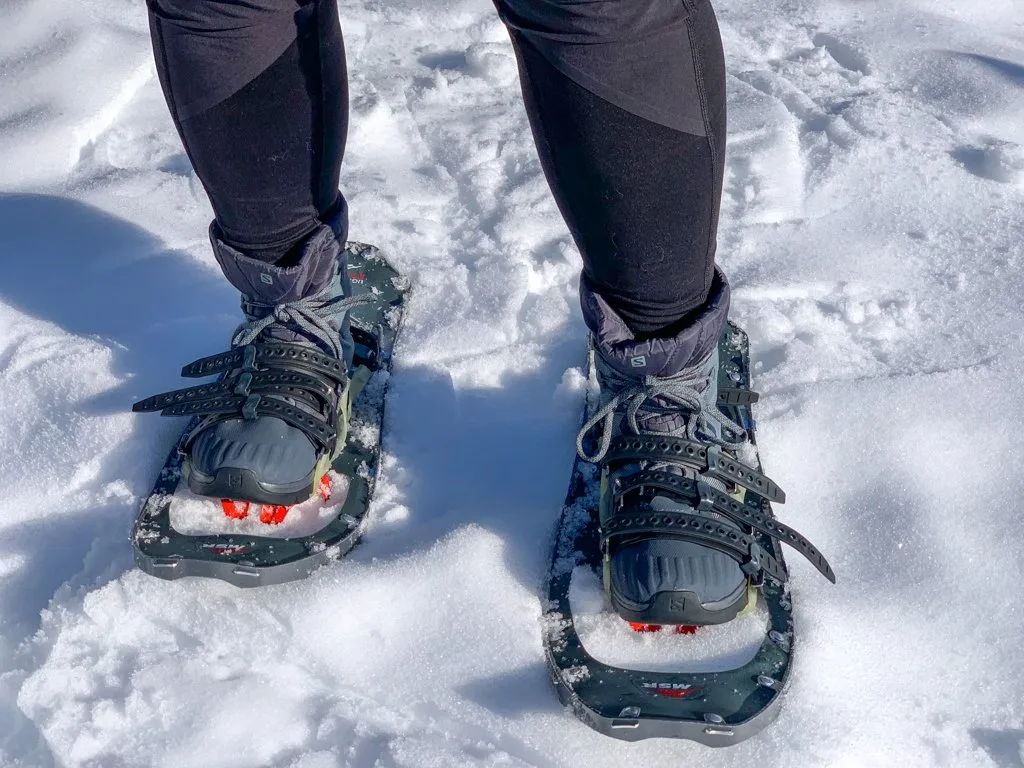
Best for: Hiking in deep snow
Pros: Can be worn with any footwear, provides flotation in deep snow
Cons: More expensive than microspikes, bulky, don’t provide enough traction for icy slopes, harder to walk in, time-consuming to take on and off
What are snowshoes?
Snowshoes increase the surface area of your foot to help you float in deep snow. There are two basic designs for snowshoes: a solid, one-piece deck or a perimeter frame with a floating deck made of fabric (or traditionally of laces).
Snowshoe bindings use straps to attach to any kind of footwear including trail running shoes, hiking boots, and sometimes bigger winter boots or snowboard boots to the snowshoes. Most snowshoes have a bit of traction underfoot, especially under the toe.
My guide to choosing snowshoes has tons more details about snowshoe construction and features.
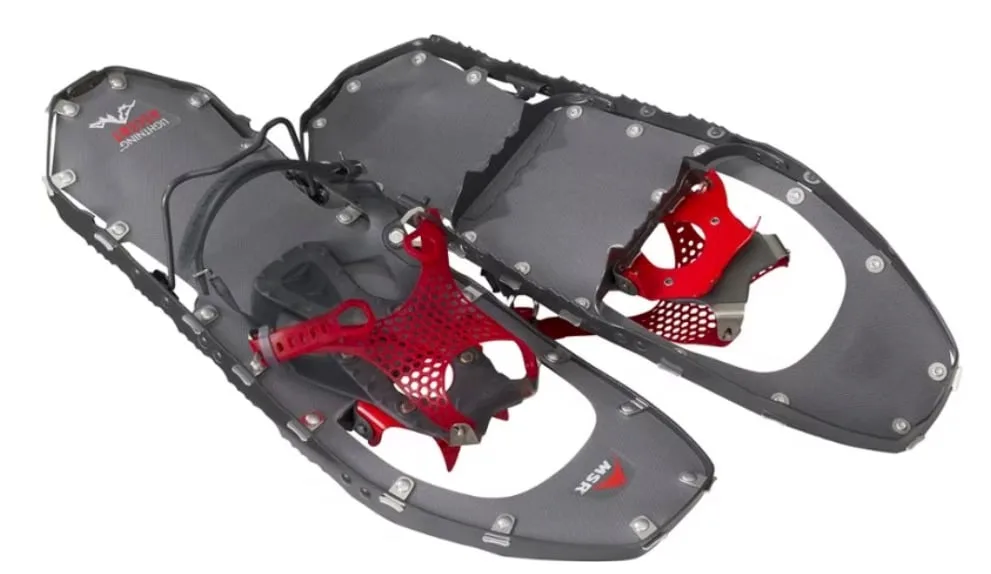
When to use snowshoes?
Snowshoes are designed to provide flotation in deep snow. They work best when trails are snowy, especially when the snow is fresh. When the snow is shallow or when it is so hard-packed that you don’t sink in, snowshoes aren’t helpful.
Snowshoes can also be dangerous on steep slopes since they don’t provide enough traction. That, combined with the wide platform of the snowshoes, makes it easy to slip and fall while wearing snowshoes. On steep slopes with long run-outs, that can result in injury or death. I’ve got more detail on this in my guide to snowshoeing safety.
My picks for the best snowshoes
I’ve been snowshoeing for over 20 years and I think MSR makes the best snowshoes. They are durable, provide great traction, and have bindings that are easy to use and fit lots of types of footwear.
My budget pick for snowshoes is the MSR Evo Trail. My upgrade pick is the MSR Lightning Ascent because they are much lighter and more comfortable to wear. You can read more about my snowshoe recommendations in my guide to choosing snowshoes.
Other Winter Traction Devices
There are also tons of other winter traction devices on the market so it can get confusing. In general, these other traction devices provide less grip than crampons and microspikes. They are all best for use in the city.
In general, I don’t recommend any of the traction devices below. I think microspikes are the best choice, even for the city. And if Kahtoola microspikes or Hillsound Trail Crampon Ultras aren’t in the budget, get the Cimkiz microspikes on Amazon – they are a better price than all of the other winter traction devices below and provide a better grip.
Here’s a quick run-down on a few other winter traction devices you might have heard of:
Kahtoola NANOspikes: These are made by the same company that popularized microspikes. They have a similar harness, but they have rubber plates underfoot with small metal studs. Snow can build up under the rubber plates.
Kahtoola EXOspikes: The EXOspikes also have the same harness as microspikes and NANOspikes but have slightly more aggressive studs than the NANOspikes and less rubber underfoot so snow won’t build up as much.
Yaktrax ICEtrekkers Diamond Grip: These have a stretchy harness that holds beefy chains with small metal cleats under your foot. These are good for the city but could cross over into a bit of hiking use.
Yaktrax Diamond Go: Similar to the Diamond Grip but less expensive since they just have a circle of cleats under your forefoot – there’s nothing under your heel. Due to the lack of heel traction, I don’t recommend these at all.
Yaktrax Run: A rubberized plate under the forefoot has short metal studs while the back has steel coils. Designed to be lightweight for running. In my experience, snow clogs in the coil style and it doesn’t provide very good grip.
Yaktrax Walk: A set of steel coils underfoot. I don’t recommend these because I find they don’t grip well.
Hillsound FlexSteps: Similar to the Kahtoola NANOspikes but with much more burly studs set into a flexible plate. Snow can build up under the plate.
STABILicers Walk: Rubber plates under the forefoot and heel have short, blunt spikes. Ok for walking on a sidewalk but I wouldn’t recommend them for hiking. Snow can build up under the rubber plate and the spikes are not sharp enough to be helpful on most surfaces.
Final Thoughts
Now that you know the difference between microspikes vs. crampons vs. snowshoes, which ones will you be bringing on your next winter hike? I take microspikes on pretty much every winter hike – I even pack them in my backpack when I snowshoe to deal with steep terrain.
READ NEXT:
- What to Wear Winter Hiking and Snowshoeing
- How to Choose Snowshoes – Get the Right Ones for You
- Snowshoeing Safety: 14 Ways to Get into Trouble and How to Prevent Them
- How to Find Trail Conditions
- Bowron Lakes Canoe Circuit: 2026 Paddling Guide - November 20, 2025
- 2026 BC Backpacking Reservation Dates You Need to Know - November 20, 2025
- 2025 Black Friday Deals for Hikers - November 19, 2025

